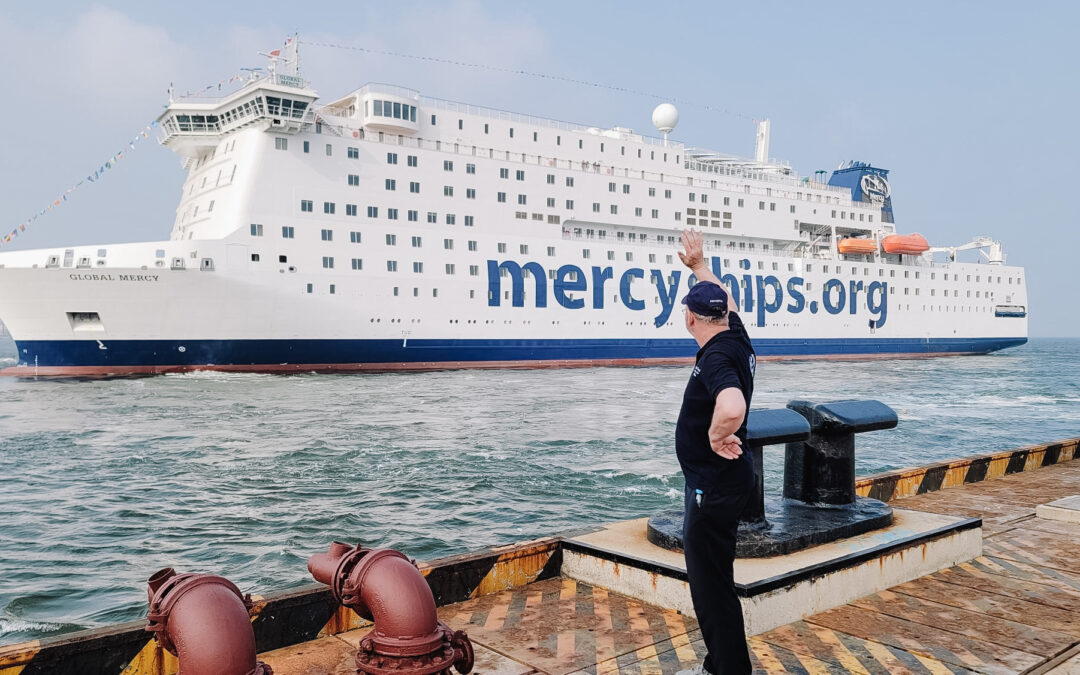The brand-new Global Mercy is the world’s largest civilian hospital ship, with a self-assumed charity mission along the African West Coast. On board, free medical care is provided to thousands of the poorest people. The China-built hospital ship has a unique design based on experience with its older sister Africa Mercy. Two central decks are fully outfitted with surgery and hospital care facilities.
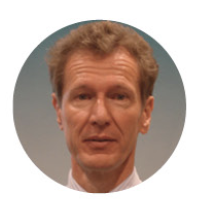
SWZ|Maritime’s April and May 2022 issues featured the two parts of an extensive article on the Global Mercy and we now present it in full here, online. It was written by ir Martijn van Wijngaarden (pictured), independent marine consultant and SWZ|Maritime guest editor.
During its maiden voyage to Europe, the Global Mercy has paid a two-week goodwill visit to the Port of Rotterdam. The visit was to strengthen the bond with numerous volunteers, corporate sponsors, societal leaders, supporting churches and individual donors.
First of its kind
Some ten years ago, the Mercy Ships organisation started developing plans for adding substantial new capacity to its African hospital ship operations. All the ships they had had in operation so far were conversions of passenger ships or ferries. This had never delivered an ideal floating hospital facility, and investments, maintenance costs plus remaining lifetime of a converted ship also proved suboptimal.
As a purpose-built new ship would have great advantages, Mercy Ships began raising funds. Founder Don Stephens entered into discussions with experienced maritime powerhouse Stena RoRo, who soon got commissioned to manage the new ship’s design and construction. Stena gladly contributed its resources to the newbuilding project from Gothenburg, Sweden.
In 2013, Mercy Ships took the bold decision to build a novel and unprecedented type of hospital ship in China. The construction costs of about USD 200 million could entirely be covered by an array of corporate and private donations. Hence, the new ship would be able to commence debt-free with its lifetime mission in Africa.
Hospital ship design
‘We began with Stena Seabird, an existing RoPax platform developed in-house in cooperation with Deltamarin,’ remarks Per Westling, Managing Director for Stena RoRo. ‘But during the design process, we developed it as a pure passenger ship with hospital services instead. You could say that we replaced the vehicle decks by operating rooms and hospital wards. But we also adapted the ventilation system and re-arranged the interior layout.’
‘We extended the accommodation decks and developed further improvements of the RoPax origin over time,’ he continues. ‘For instance, a hospital ship does not need equipment and facilities for quick turnaround of large wheeled cargo volumes in ports. Cabins on a hospital ship are bigger as the volunteering crew stays on board for long time periods. Public spaces and meeting rooms serve different functions to those on a passenger ship. And sailing speed does not matter, the ship sits in port for many months at a time and moves only once a year. In this project, we have already incorporated some elements from our growing RoPax construction standard.’
All in all, you could describe it as a successful blend of hospital ship and Stena ferry.
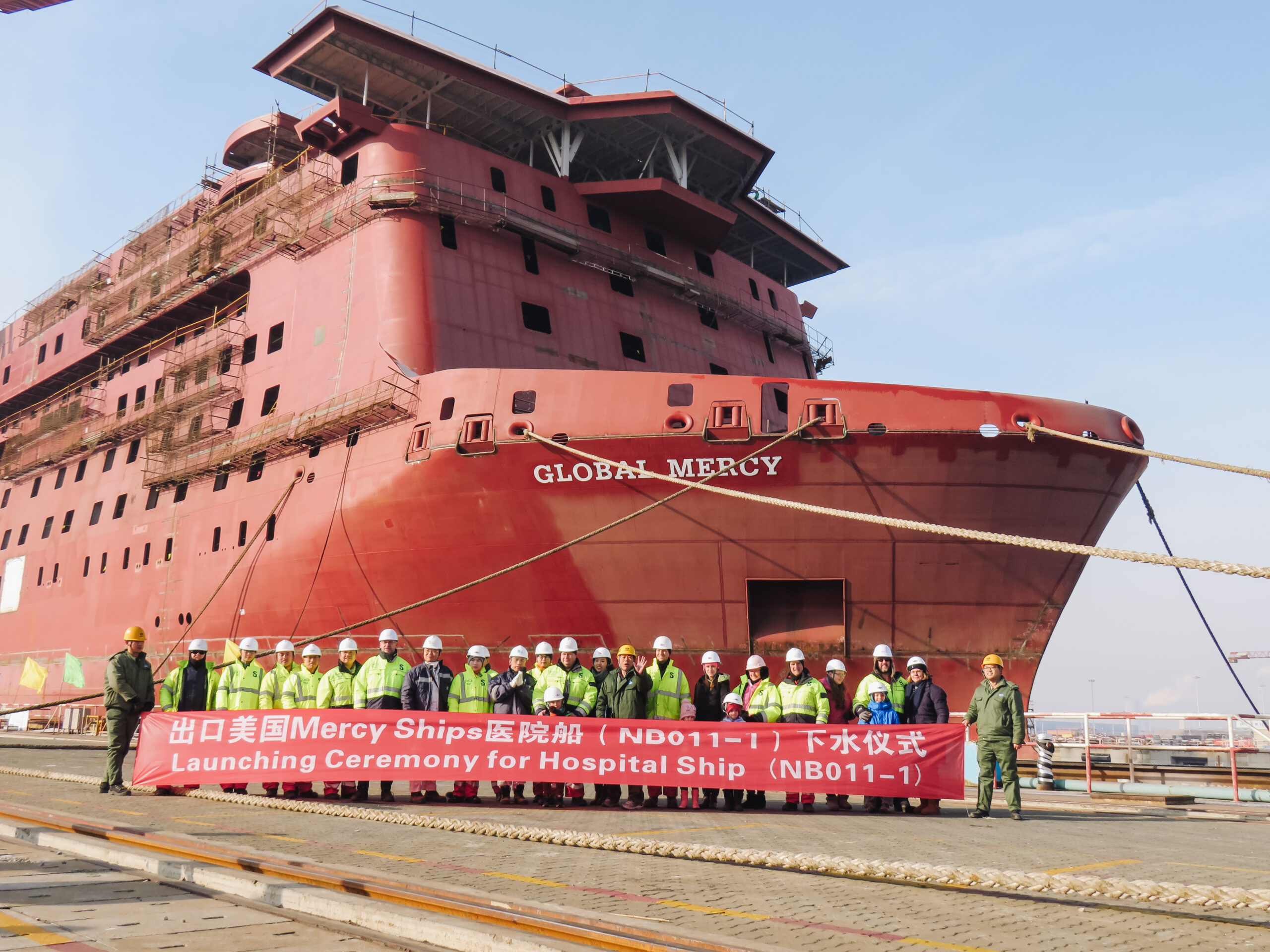
Operating in African ports
The sailing/berthing ratio in the operational profile of Mercy Ships is almost the opposite of conventional passenger ships and ferries. In a typical annual cycle, hospital ships spend up to ten months berthed in an African port. With the remaining two months available for sailing to the next port and performing major annual maintenance works. Sometimes with a short stay in yet another regional port. Few suitable repair yards are available, let alone drydocks, along the whole African continent.
‘Port conditions in Africa are the limiting factor,’ says Jim Paterson. ‘We know these conditions very well from past operations with our existing ships.’ Paterson is a Scotsman from Glasgow who joined Mercy Ships back in 1987 as Chief Engineer. He has been on board all Mercy Ships ever since and led the Marine Operations Department for twenty years. As Executive Marine Consultant, he has been instrumental in overseeing the plans and building of Global Mercy.
‘The African ports where we operate do not only restrict us in ship dimensions. Also, the water quality in harbours is extremely poor. Would you know that we employ volunteer divers to unclog our sea chests? And this hull is fitted with state-of-the-art systems for antifouling. Marine growth on the underwater parts when moored in tropical waters for such extended periods is a serious concern,’ Paterson explains.
‘We built the ship to be completely self-sufficient whilst berthed for extended hospital services in ports. We cannot rely on shore power. Although an IMO requirement in western ports in future, there is simply no stable electrical shore power available there. We have a powerful redundant diesel-electric power supply on board. Thus, we are able to supply some of our power surplus to provide shoreside clinics and their ancillary facilities with stable electrical power. The only thing we need from shore in these African ports is raw water. Our water treatment facilities on board (to Hatenboer standards) turn this into the high quality drinking water we need for hospital facilities and crew quarters,’ Paterson concludes.
Campaign support in Africa
Mercy Ships operate in Africa’s sub-Sahara region, mainly at the West-Atlantic coast. Typical ports called during successive health campaigns in West-Africa are Conakry, Freetown, Monrovia, Lomé and Cotonou.
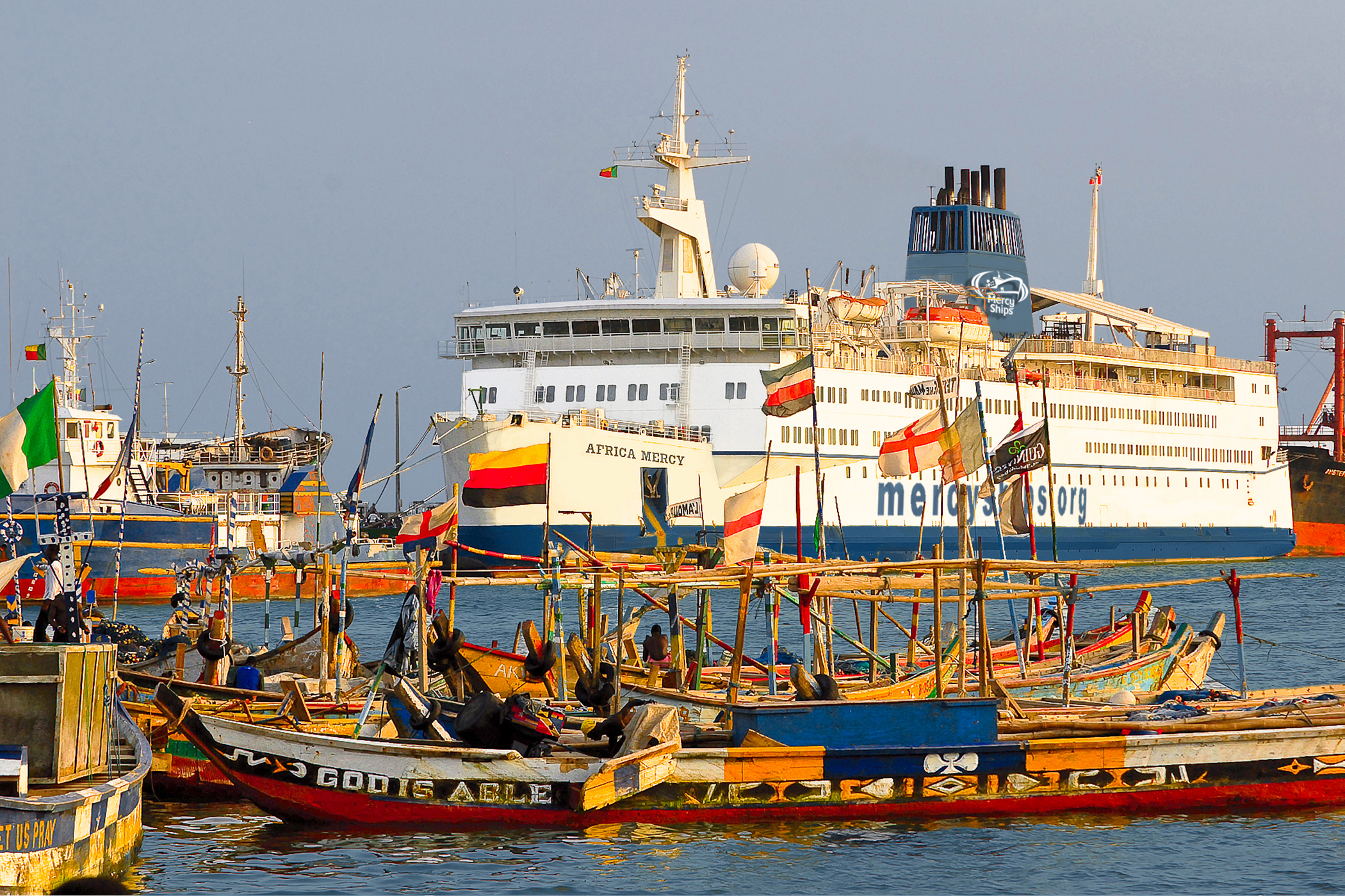
Mercy Ships travels to African host countries only after official government invitation. This ensures co-operation of the government itself, local authorities and institutions, public facilities, churches, health services, utility providers, and port authorities. It is absolutely vital to ensure full local co-operation for the ground operations in any country. Preparations already start two years ahead of arrival.
Advance Teams arrange all facilities and logistics needed for the medical services provided on board. And increasingly, co-operation with local hospitals and clinics, and educational institutes. The Advance Teams screen the patients earmarked for hospital treatment, and carefully plan their appointed admission to the hospital ship. Patients requiring major surgery with expected longer after treatment are scheduled early in the ship’s campaign. They obviously need to be fully cured and recuperated, and in any case dismissed before the ship leaves port. The Advance Teams also set up temporary medical and dental outpatient treatment facilities on shore.
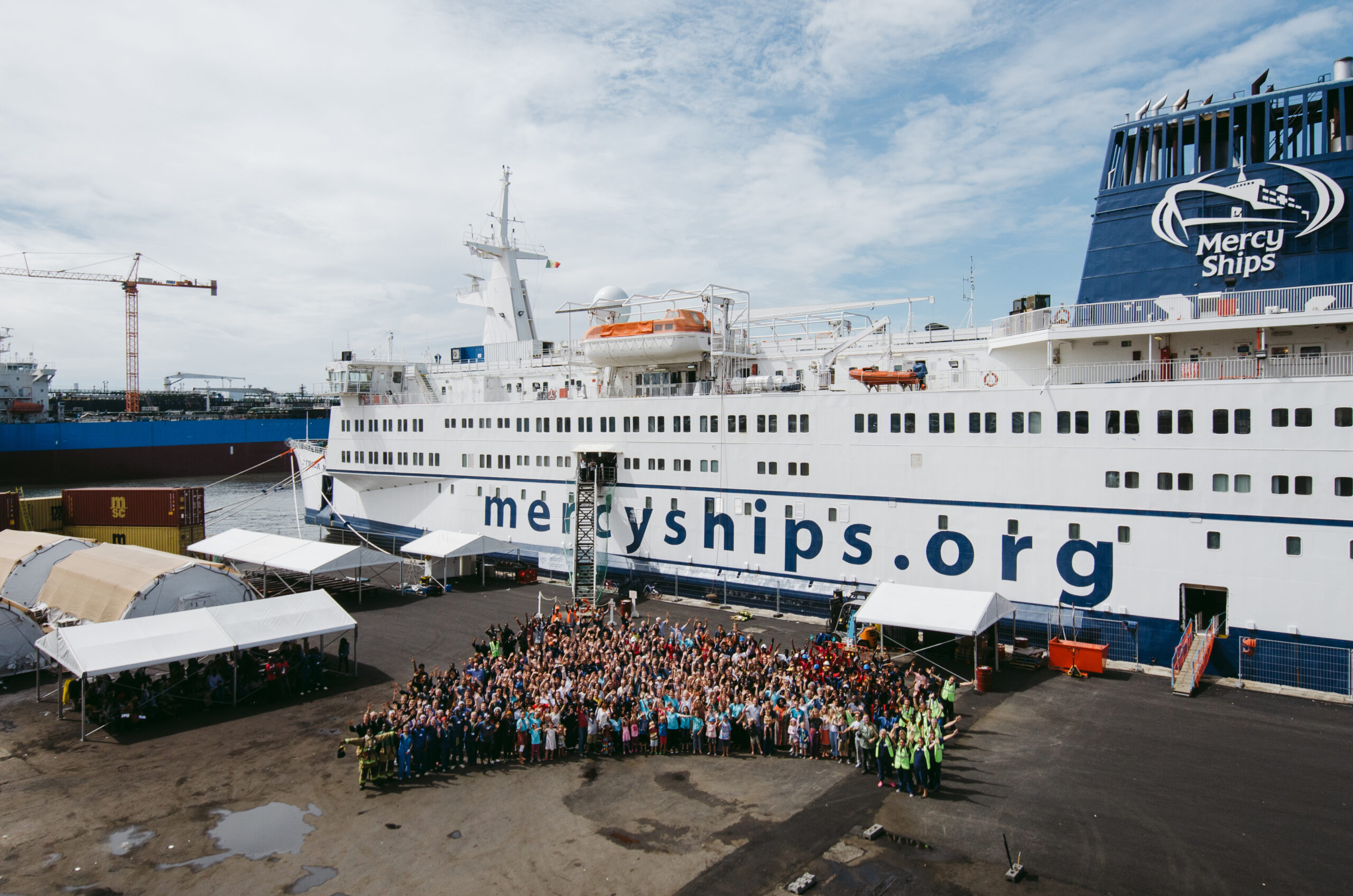
A daily stream of patients, accompanying family members, local staff and trainees needs to embark and disembark in a well-organised sequence. And this flow in turn needs to match with Mercy Ships’ own cars and locally sourced inland transport facilities. The ship can handle limited amounts of building materials, tor of Mercy Ships Holland. The material and personnel flow in African operations is likely to increase in future, not only because Mercy Ships will now operate two hospital vessels, but also because it is going to expand its inland operations with education, healthcare and agriculture improvement programmes in countries of need.
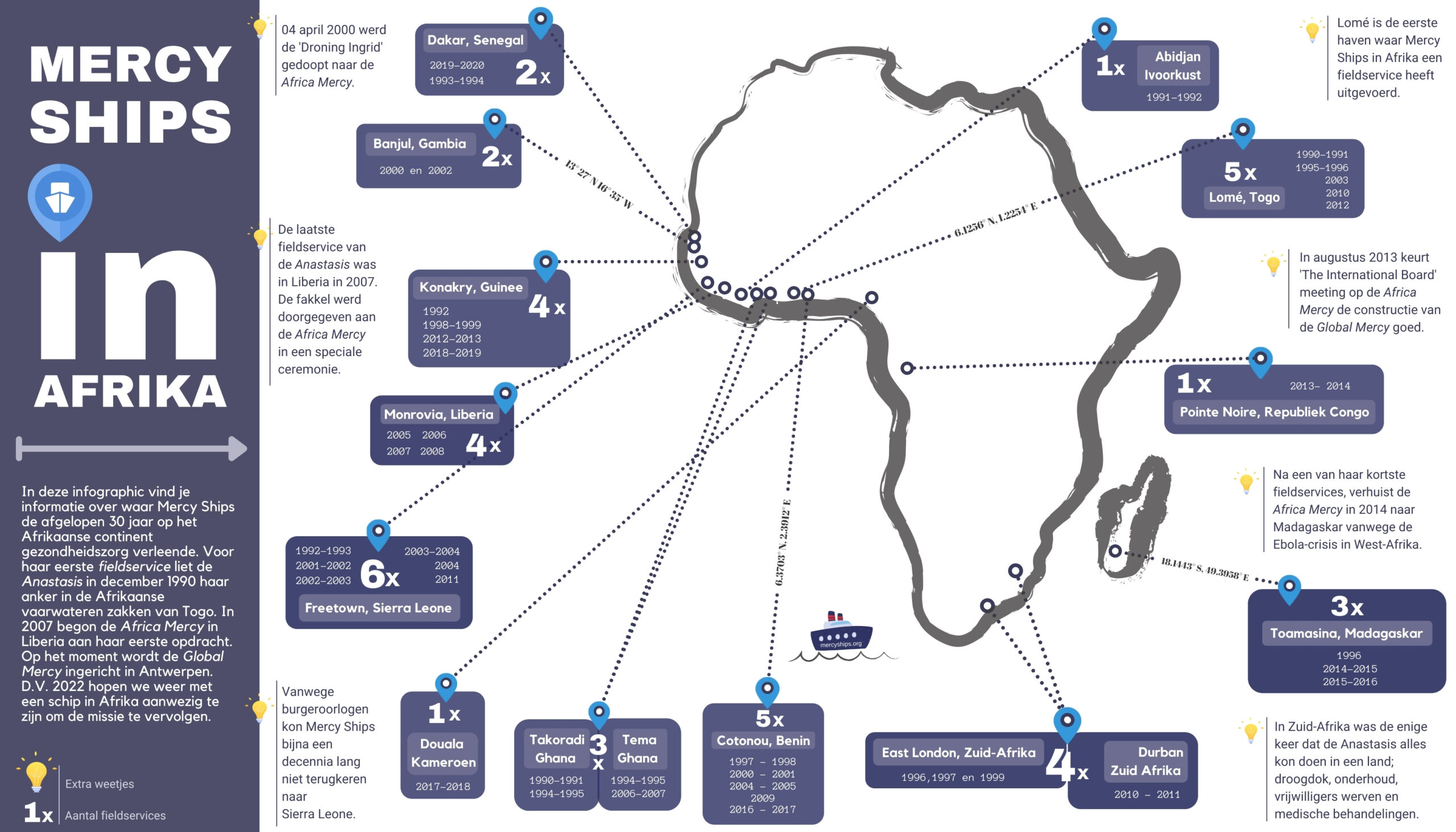
Purpose-built hospital ship
Whilst Global Mercy’s silhouette may resemble a RoRo passenger ship, inside the ship everything is designed and constructed with the sole purpose of providing a maximum of efficient and human-centred hospital treatments, with all the required amenities and supporting facilities laid out in a functional manner. Deck heights, room sizes, passageways, doors, stairs and lifts are all laid out for optimal service and easy personnel and material flow, thus combining a caring environment with ship-routine logistics performance.
Centrally positioned are the two fully rectangular decks with 7000 square metres of surgical suites and hospital wards. Above are the expansive crew lodging, restaurant, recreation and education facilities. The fully equipped nautical bridge is manned only at sea. On the open aft deck are two store cranes for ship provisions, shore materials and vehicles. Less visible to visitors and only accessible to authorised crew members are the machinery and storage spaces below the lower hospital deck.

The ship is equipped with four Wärtsilä W6L32 medium-speed diesel generator engines delivering 3360 kW each. Propulsion and steering go through twin 2850 kW ABB Azipods. The diesel-electric power system is constructed with fire safety and redundancy as criteria. Apart from uninterruptable essential hospital services, this also provides compliance with the modern-day SOLAS requirement for Safe Return to Port for this grade of passenger ship.
Hospital decks are fitted with dedicated systems for power supply, potable water, sanitary discharge, HVAC and oxygen supply. The ship’s environmental footprint in African ports is minimal. The only wastes produced are treated water and ash. Any person visiting the ship or living on board enjoys the bright Scandinavian interior architecture of messrooms and meeting rooms. The central galley can serve up to 3000 meals a day.
Experience from Africa Mercy
For many years now, Africa Mercy is the only hospital ship in operation, with many crew volunteers knowing no other home away from home. The ship was originally built as Danish train ferry Dronning Ingrid and converted into a dedicated hospital ship by A&P Shipyard, Newcastle-upon-Tyne. The refit had cost USD 62 million and was regarded the largest ship conversion in the UK.
Commissioned by Mercy Ships in 2007, the ship has already completed fifteen medical campaigns in various African countries. The field experience gained by these operations has provided invaluable inputs to the design, construction and operational preparations for the Global Mercy. For instance, the Africa Mercy hospital facilities are not big enough once local doctors are brought in for training, and container storage and social space is limited.
After leaving Rotterdam, the Global Mercy has set sail to Tenerife for final completions. Then it will continue to Dakar, Senegal, for the naming in the presence of the Africa Mercy. Marine and medical crew will be transferred there to Global Mercy as Africa Mercy heads for an unpostponable maintenance stint.
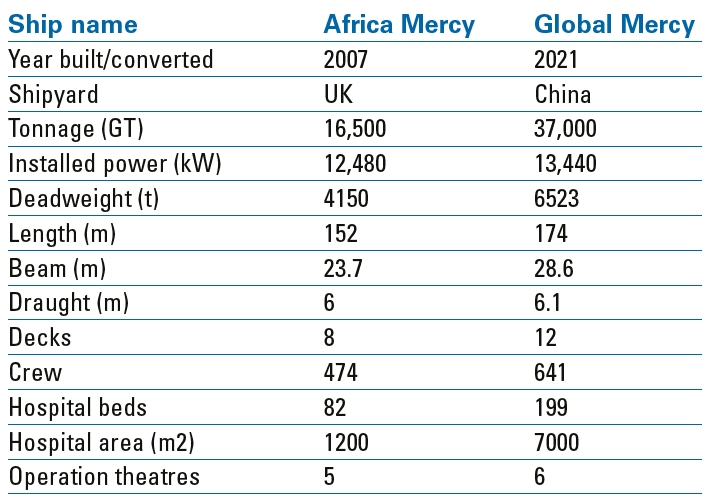
Construction and testing
Tianjin Xingang shipyard in China was contracted early in the newbuilding project, with the advantage of incorporating many reputable European suppliers in the building specifications. As it was the first ever passenger-type ship built to international regulations and standards in China, Stena RoRo fielded a strong supervision team, with a good mix of nationalities, and all discipline leads having many years of overseas newbuilding experience. Detailed design was carried out by Deltamarin, the Finnish ferry and cruise ship specialist.
Before construction and outfitting of the accommodation decks, the site team had the shipyard building a scale 1/1 mock-up of a deck’s section. This set a clear benchmark on agreed workmanship and prevented endless discussions on standards. Unfortunately, equipment and material deliveries to China and provision of expert manpower were hampered by transport and travel restrictions imposed during the Covid-19 pandemic. This affected, for instance, the sophisticated solid and liquid waste handling systems to be installed on board.
Eventually, the ship was delivered to Mercy Ships by the yard in June 2021 after successfully passing extensive deep-water sea trials. Strict HVAC system performance requirements were tested and proven for noise and vibration in the delicate hospital areas and crew quarters. Now the ship was ready to undertake its first and longest sea voyage to Europe, passing through the Suez Canal.
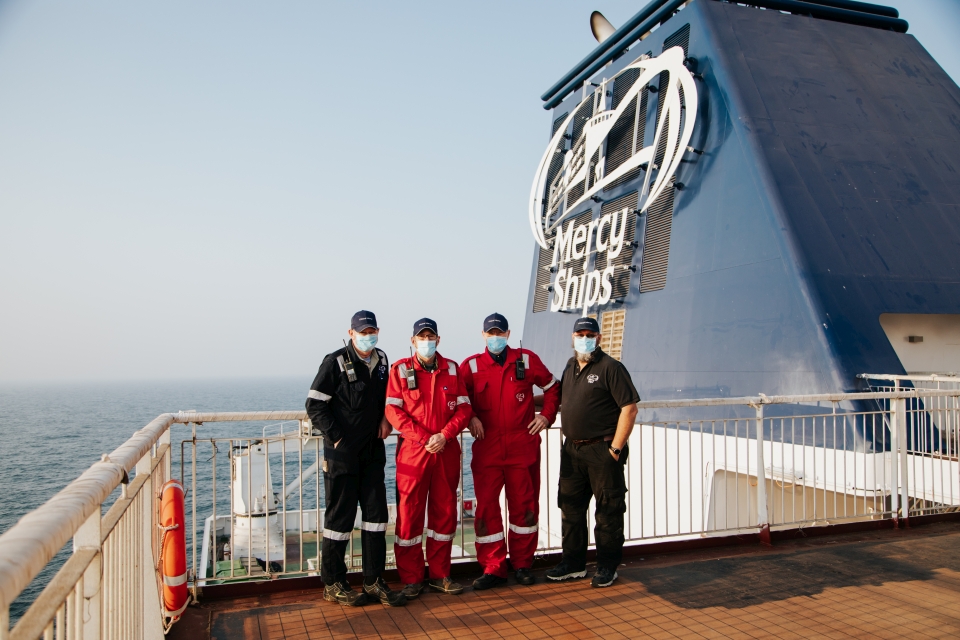
Patient treatment and care
Mercy Ships provides a range of surgical treatments ranging from orthopaedic foot and bones corrections, congenital deformities reliefs, fistula repairs, skin tumour removals, cleft lip and palate corrections to eye surgery and dental care. Those who are treated within the same day will stay in the general outpatient, eye and dental clinics. Those who will receive more elaborate surgery will be made comfortable in the wards, with 200-bed capacity. This capacity is split into acute care and self-care beds. For the latter, patients are assigned an innovative bunk bed with the bottom tier allocated to their accompanying family member.
Surgical deck 3 is isolated from public facilities and accessible to authorised medical staff and their patients only. Around the centrally positioned six operating theatres all required support facilities are laid out. Needless to say, the hospital can avail of the latest radiology equipment for X-rays and CT-scans. And laboratories, pharmacy and hospital supplies are on standby. The emphasis is on planable and specialised surgical care that does not require long-term aftercare or rehabilitation and contributes to quality of life.
THE GLOBAL MERCY EXPERIENCE
The ship’s open house organised by Mercy Ships Holland inviting the public for a one-hour guided tour through the interiors of Global Mercy was a big success. In fifteen days, some 10,000 in-person visits were hosted along with 4300 virtual tours. Audio-visual displays and even holograms brought the unmanned hospital treatment facilities to life.
Many visitors brought their friends and colleagues. Families with small children also took this rare opportunity to see the new ship from the inside. For some it was their first time on board such a large seagoing vessel. Did they realise that when the ship is moored in Africa, the young patients and their accompanying family members will come on board over the same central gangway, anxious to set foot on this miracle of a 21st century hospital?
Visitors in Rotterdam left the aft ship over the same gangway where the healed patients will jump off to a happier life in Africa. To many young visitors the special hospital ship made a lasting impression. Says Mirjam de Vos, HR Director at the Wilhelmsen Group: ‘I joined the tour with my husband, a professional architect, and my 3-year old son. It inspired us to talk about volunteering ourselves. I could certainly join in the HR sector, and we learned that my husband would be welcome to work in construction of Mercy Ships buildings onshore. And my son? He said he wants to be a doctor on board!’
SWZ|Maritime reporter Mariska Buitendijk also immersed herself in the Global Mercy Experience. A lively visit report with extraordinary Rotterdam blue sky photos can be accessed here.
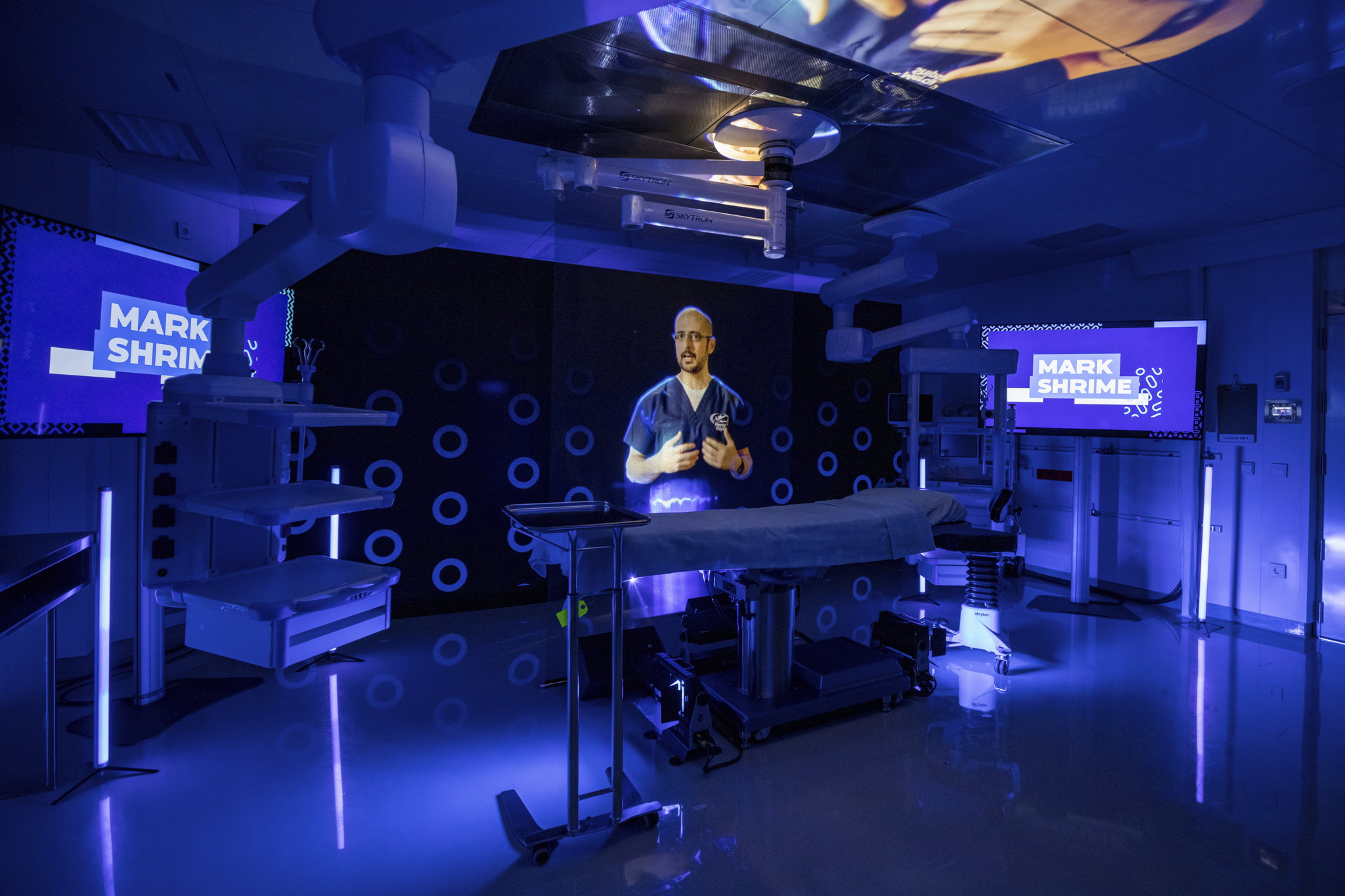
Simulation lab training
When the Global Mercy leaves a port, having completed some 3000 medical treatments, it wants to leave a lasting improvement of local healthcare behind. That is why local students are trained in classrooms, an OR simulator, and a simulator lab using the latest virtual- reality and augmented-reality equipment. In the simulation lab, trainers can simulate local conditions and limitations in order to teach best medical practices in low-resource operating situations.
Medical outfitting and commissioning
On its maiden voyage to Europe, Global Mercy first docked in the Port of Antwerp. All medical outfitting equipment was brought on board and some already installed. The flagship attracted a lot of attention during its first official port visit and already celebrated huge support from European companies and volunteers. It even got its own comic book: the well-known Belgian comic Suske and Wiske titled “De Drijvende Dokters” was launched.

Before departure, the ship was stocked and partly crewed to proceed to Rotterdam. ‘Not only commissioning the usual ship’s marine systems, but also new medical systems inside the ship simply takes time. Unlike most ship operators, we are luckily not under commercial pressure for first public operations,’ clarifies Dutch Chief Engineer Irik Mallie. ‘We’d better have our facilities thoroughly tested and our medical crew fully trained before we enter African port operations. Being docked now in Rotterdam is excellent, there is no way you can commission these high-grade operation theatres, with advanced systems and delicate software, once the ship is in transit or in Africa.’
Rotterdam port visit
Dutch Director Martijn Provily has prepared for the visit to Rotterdam with his staff and some 300 bi-lingual volunteers. ‘It is a unique opportunity for us to let as many Dutch people as possible see our mission up close,’ he says. ‘And possibly the only opportunity to get on board the ship here in Rotterdam, as there are no plans to return to Europe once the ship starts operating in Africa.’
One of the key Dutch staff in attendance is Hendrik Jan Groeneveld, an independent businessman who works as a volunteer one day per week for Mercy Ships Holland. He is their Companies Ambassador and engages Dutch companies to pledge and effect support for Mercy Ships. He asks companies persuasively for at least one of his four favourite Ms: Manpower (volunteers), Media exposure, donation of Materials, or Money as direct financial support.
During the Rotterdam port call, he seizes the opportunity to organise a series of fundraising events on board and ashore. This way he forges strong corporate partnerships like the Mercy Ships Network. This network unites over sixty Dutch companies donating under their voluntary Corporate Social Responsibility.
Global crew of volunteers
The multi-national Mercy Ships organisation is largely built on professional self-funded volunteers. These crews spend up to two years on board, sometimes joined by their families. Mercy Ships Holland recruits volunteers, undertakes fundraising, and runs the overseas fleet logistics from Rotterdam. Global Mercy enjoys through-life maintenance support from numerous international maritime companies to sustain its shipborne humanitarian activities. The organisation aims to remain operational in Africa for decades to come and hopes for further fleet renewal and expansion.
Mercy Ships is a charitable institution established in 1978 with its headquarters in Texas, USA. It operates through local offices in sixteen countries. Fleet management operates from the USA. Every country organisation is engaged in fundraising activities and sourcing of professional volunteers to serve for the short or long term in key marine, medical and miscellaneous positions on board the ships.
As the Mercy fleet more than doubles in capacity with the advent of Global Mercy, the NGO is planning ahead to ramp up financing, logistics and recruitment of its voluntary personnel on board. The leadership, local management, permanent staff and professional volunteers of this global non-profit organisation are inspired by core values of Christian faith. They serve Mercy Ships to provide free medical care for the poorest children and young adults in developing countries.
The professional volunteers are the backbone of Mercy Ships. On board the Global Mercy, the mixed crew is a transient community of some sixty nationalities bringing a vast range of skills and competences to run the hospital ship’s daily operations. They share a strong motivation for their humanitarian work and live closely together on board feeling like one extended family.
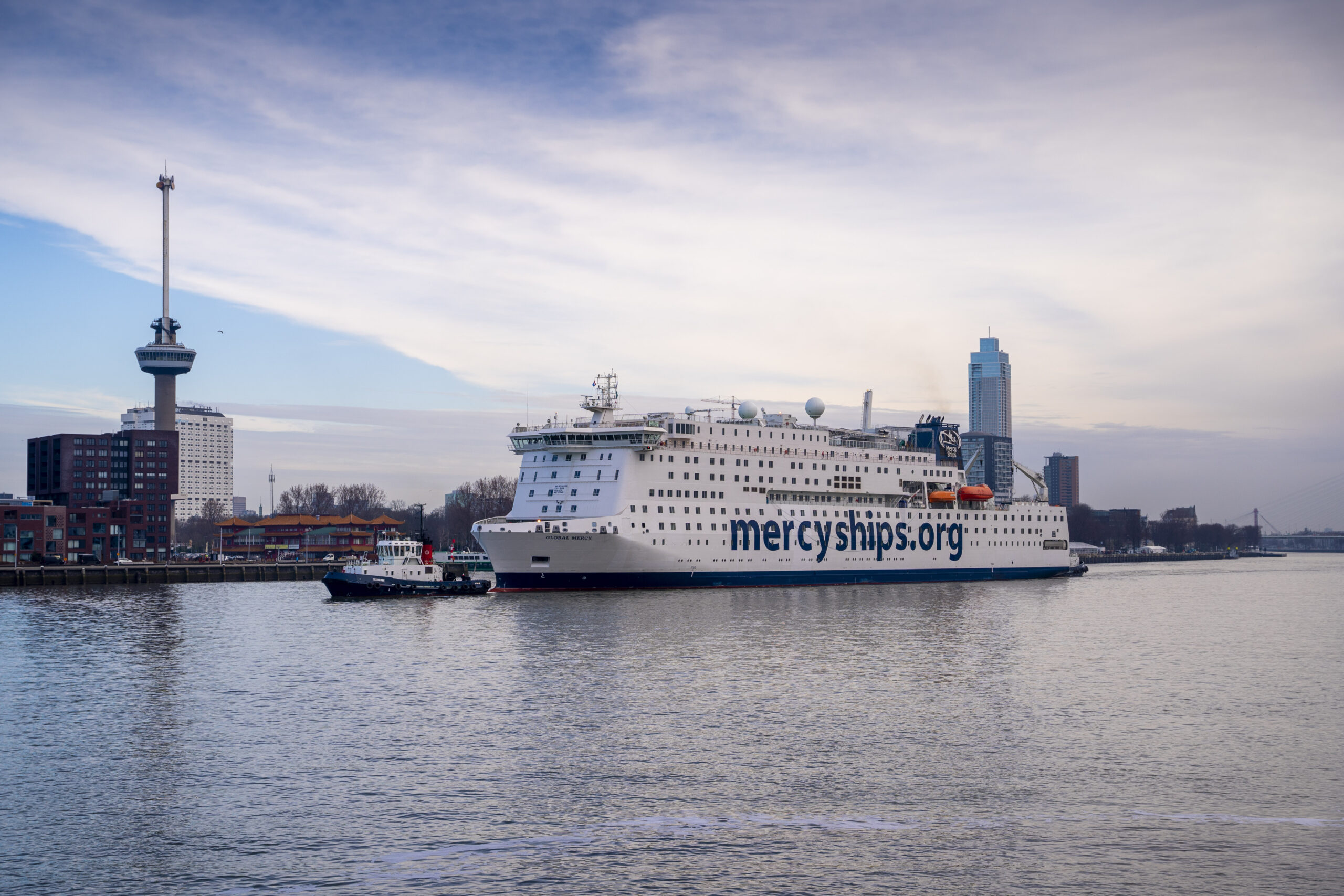
Global Mercy has a crew capacity of 641 persons, with additional space to host up to 950 people anytime when in port. The ship’s experienced marine and technical crew is in fact a minority on board. Medical crew warrant all the required competences on board, ranging from highly specialised surgeons to qualified nurses. In addition, there is a large number of crew in various support duties. On a ship this size, you always need galley and messroom staff, and of course housekeeping, laundry, and cleaning staff. To sustain the ship’s mission, you cannot do without skilled maintenance, storekeeping, administration, and security professionals.
The Mercy Ships’ troopers, who will stay on board for anything between two weeks and two years, have a range of educational and recreational facilities at their disposal. The crew quarters are fitted with a library, theatre, gymnasium and swimming pool. These high-standard facilities in turn need to be manned and maintained.

A remarkably large share of the standing crew consists of couples, both working in different services on board. Some stay on board for months or years with their young families. For these children, the ship provides day-care and education. So, teachers are employed on board as well.
‘Our Mercy crews are true volunteers, they often take unpaid leave from shore jobs, pay a monthly fee to cover their own board and lodging, and purchase their own travel tickets for embarkation. Where else will you find dedicated professionals paying for their own workplace?’ asks chairman Jan van den Bosch in his welcome speech to the more than 150 maritime industry representatives hosted on board during the International Maritime Day event.
Well-known philanthropist Van den Bosch is the figurehead of Mercy Ships Holland. He has a kind word of encouragement and expresses his gratitude for each and every person he meets.
Recruitment drive
A prime task of Mercy Ships is the recruitment and retention of sufficient volunteers, in all trades and grades needed. Luckily, there are many repeat volunteers. In fact, these are the organisation’s best brand ambassadors, always prepared to share how eager they are to bring their capabilities on board, and reflect on how this experience enriches their lives.
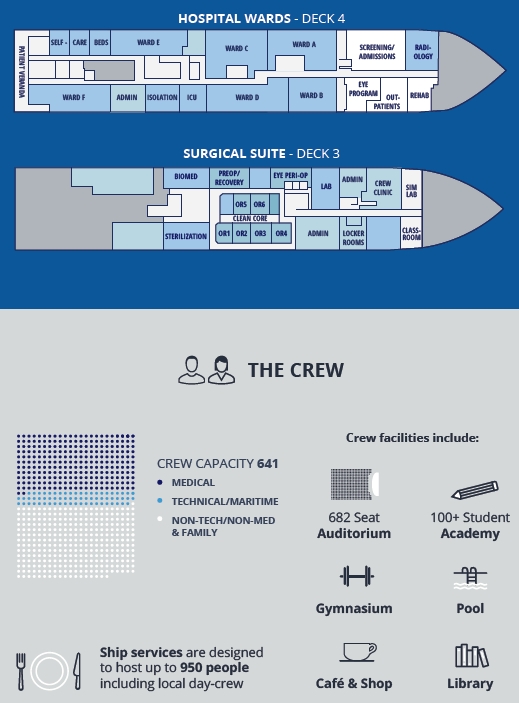
Funding and community support are essential for all volunteers joining a Mercy ship. Some families run their own websites and newsletters from the ship.
With the advent of Global Mercy expanding Mercy Ships’ fleet operations, capacity in Africa is more than doubled. Hence the need for recruiting a large workforce for the new ship. There is a waiting list on the medical side, but there is an ongoing need for qualified deck and engine officers and ratings. The Rotterdam port visit was a prime opportunity for recruitment.
All the ship‘s departments require qualified staff. Mercy Ships seeks employers willing to lend them their talents. Some employers are prepared to grant seconded staff unpaid leave, or even sponsor their subsistence and travel costs from corporate funds. For the volunteer, there is a small risk of career interruption when joining Mercy Ships for some time. But high-calibre seafarers are always in demand, and training and experience on board will most likely broaden the person’s perspective.
‘And look at it from an employer’s side,’ says Mirjam de Vos, HR Director at Wilhelmsen Group. ‘He may well get a more all-round professional back, who has developed as a person with enriched experience in multi-disciplinary teamwork.’
LIFETIME CAREER
Every visitor coming on board in Rotterdam gets a safety introduction in a video welcome message by Captain Taylor Perez. He is the most senior (70) of the four Mercy Ships captains who command the two ships in a mutually agreed rotation. He has a very distinguished career at sea with Mercy Ships as master since 1985. He met his wife on board an earlier Mercy Ship and has devoted his life to serve on board.
He recognises the need of younger volunteer crew members for having a spell-off from the sometimes demanding working conditions on board. We learn a new acronym from this soft-spoken gentleman: PTO, which stands for Personal Time Off. This relaxing and enriching period is often spent onshore in Africa.
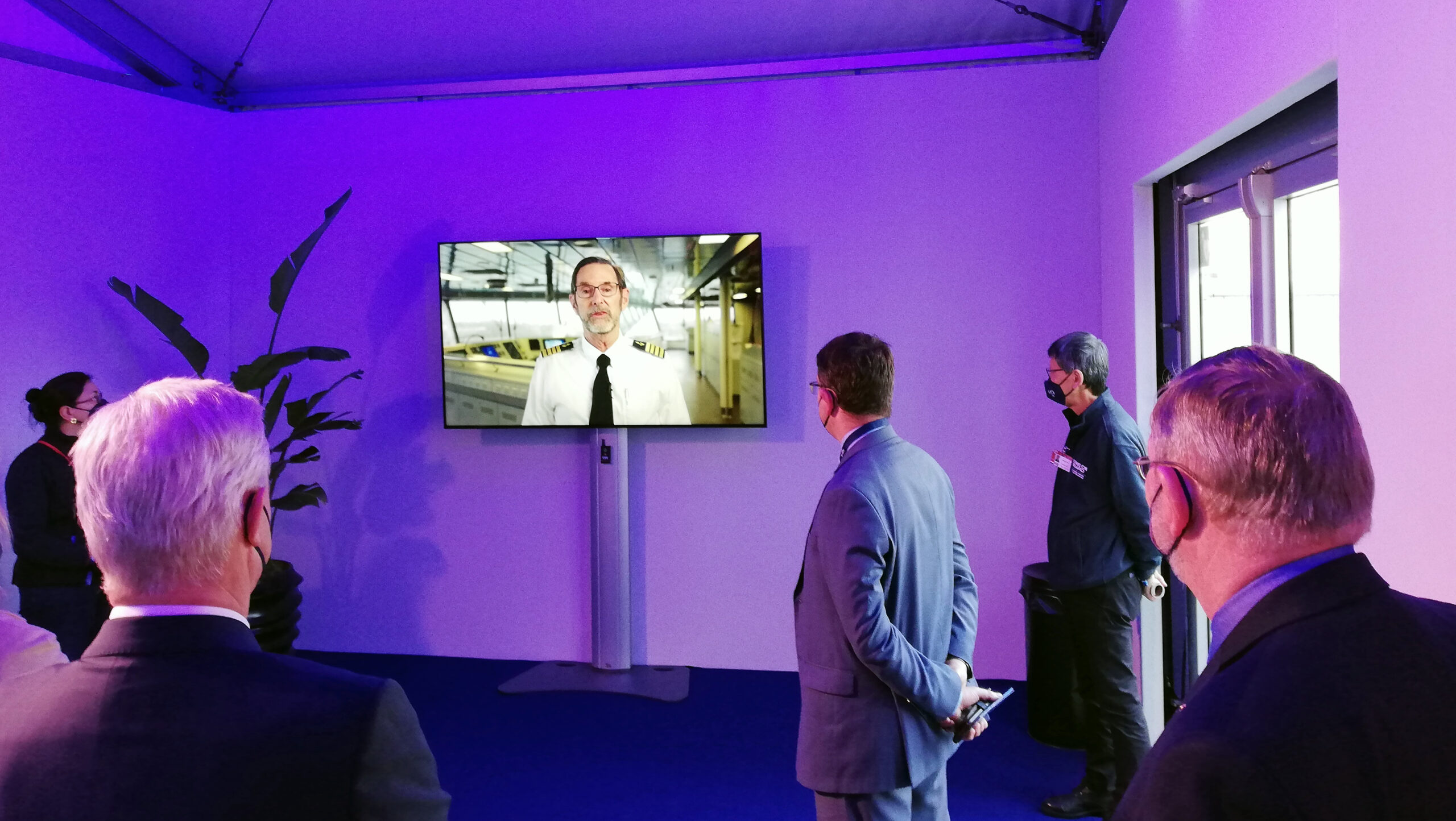
Mercy Ships Holland
At lunchtime on board, SWZ|Maritime meets Martijn Provily, freshly appointed as National Director to run and expand the Mercy Ships Holland organisation. Amidst shaking hands with the many VIPs and maritime industry guests, he manages to give a short introduction of his country organisation’s position. ‘We are based here in Rotterdam, within short distance of hospitals, universities and major maritime businesses. This enables us to build close relationships with nearby institutions and companies that are indispensable for our hospital ships operations.’
MAIN ACTIVITIES FROM ROTTERDAM
Mercy Ships Holland undertakes three main activities from Rotterdam. National Director Martijn Provily explains:
- Firstly, we recruit and place volunteers. Surgical care and medical training courses are conducted by our professional volunteers. Mercy Ships Holland recruits Dutch volunteers who work for a short or longer time on our hospital ships.
- Secondly, we purchase and distribute materials for the hospital ships. Mercy Ships Holland takes care of the procurement of medical devices, food and other materials needed for our hospital ships and the various onshore project locations. Due to our central location in Europe, close to the main port of Rotterdam, we are well positioned as a logistics collection point for goods from all over Europe. Our European Distribution Centre ships these in containers to the hospital ships berthed in Africa. And we air freight medicines for the African hospitals in our specially developed cooling bags. Sometimes hand carried by local expeditors of our highly co-operative ground handling agents.
- Thirdly, we undertake fundraising and public relations activities. Mercy Ships’ work requires a lot of money. Mercy Ships Holland contributes by raising funds among individuals, companies, organisations and churches. The relationship with these stakeholders is key. We also run programmes and campaigns, organise events and actions to
make the Dutch people aware of the great medical need among the poorest in developing countries. In this way, we increase support for the objectives of Mercy Ships.
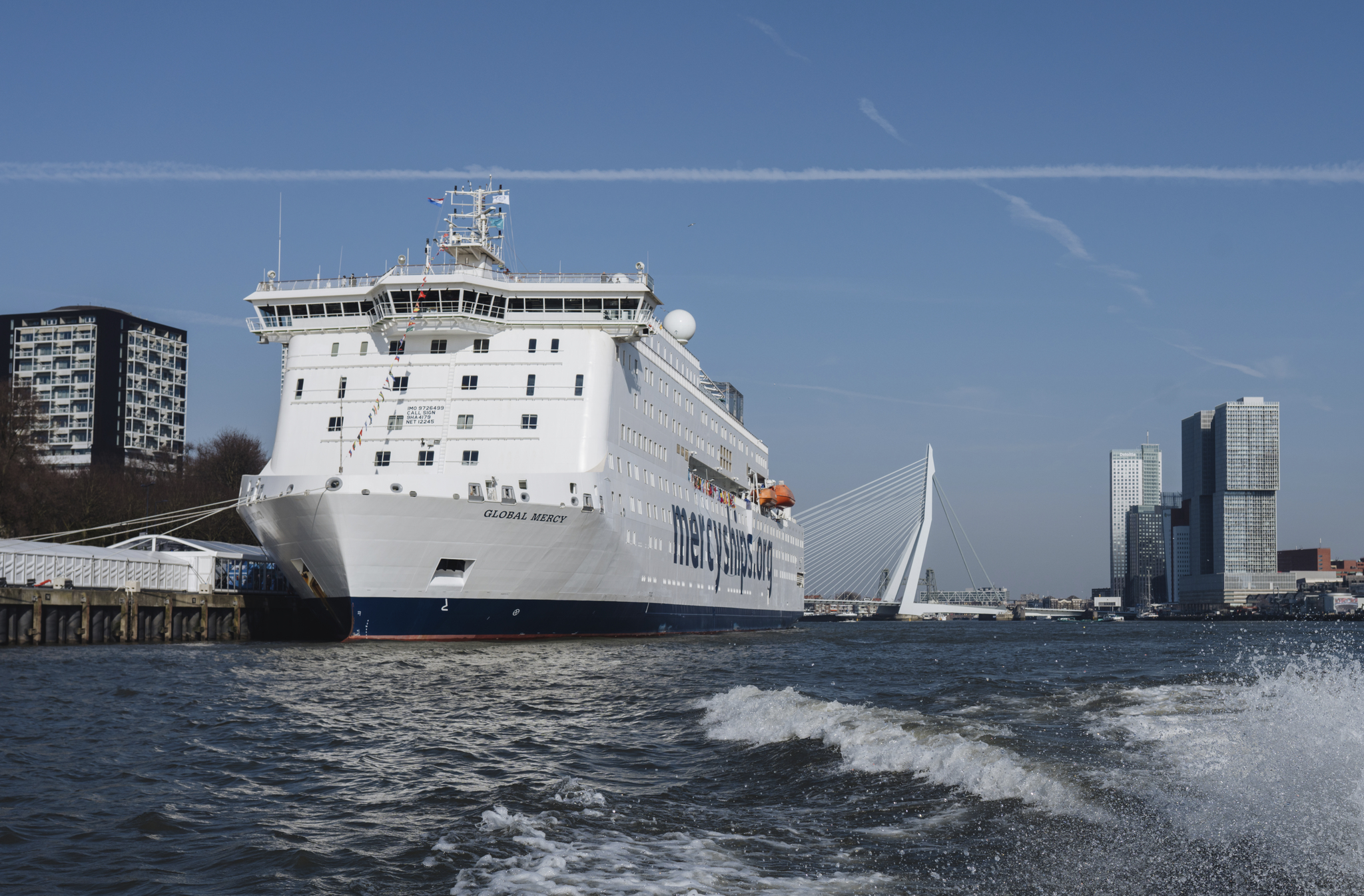
Maintenance and repair assistance
Major equipment suppliers like Wärtsilä have offered Global Mercy a five-year services maintenance agreement, which covers parts, field service, asset monitoring, and full technical support to keep the hospital ship running at all times. ABB also provides global 24/7 technical support. Many other maritime companies lend their support to the ship’s operations, by donating equipment servicing and spares, providing training services or allowing their employees to spend extended leave as volunteer crew on board.
There is yet another way companies can provide direct technical support on board during the intensive maintenance and repair periods, whilst the ship is in transit to another port for its next ten-month continuous medical campaign.
Within these two months of sailing, including a major stopover in a suitably equipped port for maintenance, the serving marine, medical and support crews are partly exchanged, prepared and trained for the next operations. Technical specialists from regular suppliers and various maritime companies come by Mercy Ships invitation to reinforce and relieve the ship’s all-round regular crew. Typically, the supporting technicians board the ship as a flying squad for a couple of strenuous, but rewarding weeks.
One such maritime company sending volunteer technicians to support the crew during an annual hectic 24/7 repair and maintenance project, is Dutch ship and dredging equipment builder Royal IHC. Their Mechanical Engineer Peter Jan Moerman first got involved as project assistant when the Africa Mercy was serviced in Durban drydock in 2015. Since then, he has voluntarily assumed the role of Mercy Ships Ambassador at IHC.
‘This way, I can devote my technical and project management skills to this wonderful charity organisation I strongly believe in,’ he says. ‘As a team with hands-on technical skills, we are ready to come to the ship for a port or drydock repair period. We spend our two weeks on board using our “paid leave” days. Our travel costs, materials and equipment are facilitated by the IHC Foundation. This fund supports us as part of our Corporate Social Responsibility.’
IHC MAINTENANCE JOBS
Typical annual maintenance jobs assistance for Africa Mercy carried out by Royal IHC Foundation volunteers:
- Replacing AC fans
- Replacing / repair porthole sealing parts
- Supporting ship’s carpenter
- Installing playground equipment
- Fabricating seafastening brackets for lashing of equipment during transit
- Installing furniture
- Supporting ship’s plumber (fixing leakage, installing sinks, etc.)
- Overall maintenance (rust removal, painting, etc.)
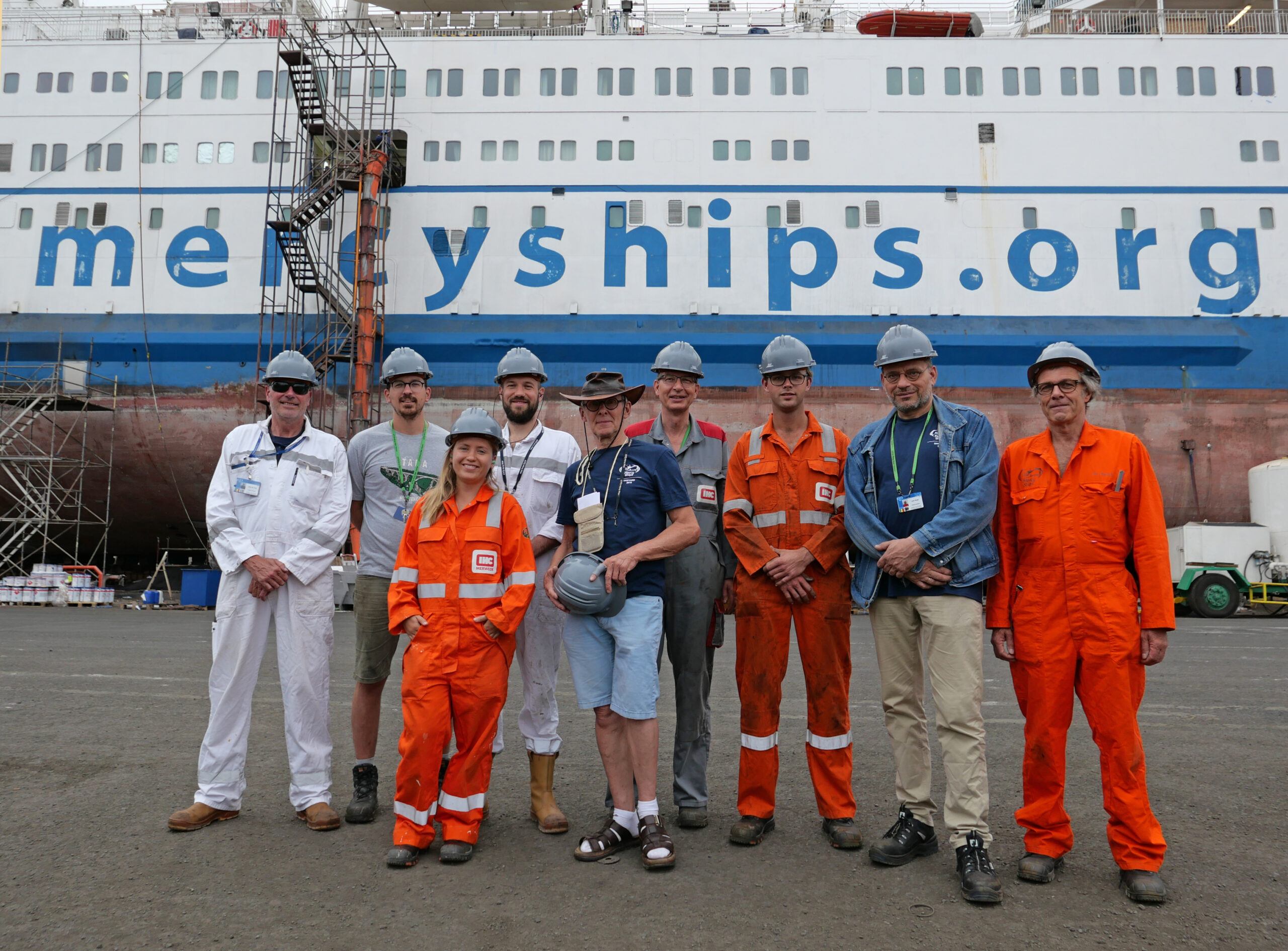
Contribution to Sustainable Development Goals
Global Mercy is built for long port stays as a floating hospital. Its hull, machinery systems and interior design are optimised to last for 45 to fifty years needing minimal maintenance and repair downtime. It is expected to host 150,000 hospital treatments on board.
‘Global Mercy’s versatile layout as a modern passenger ship enables it to adapt effectively and sustainably to future technology advancements as the opportunities arise,’ says Nima Moin, surveyor from Lloyd’s Register’s (LR) Rotterdam office. He is convinced that technological developments in shipping and medical sciences will change the onboard standards, facilities and also the crew composition over time.
Moin has been volunteering with Mercy Ships for many years now and takes great pleasure in LR’s years of partnership in providing marine classification services to Mercy Ships. Mercy Ships’ unique trade contributes to securing equality, peace and prosperity for people and the planet now and into the future. These ships not only deliver free medical care in the least developed countries, but also empower local medical staff by providing them with training and equipment.
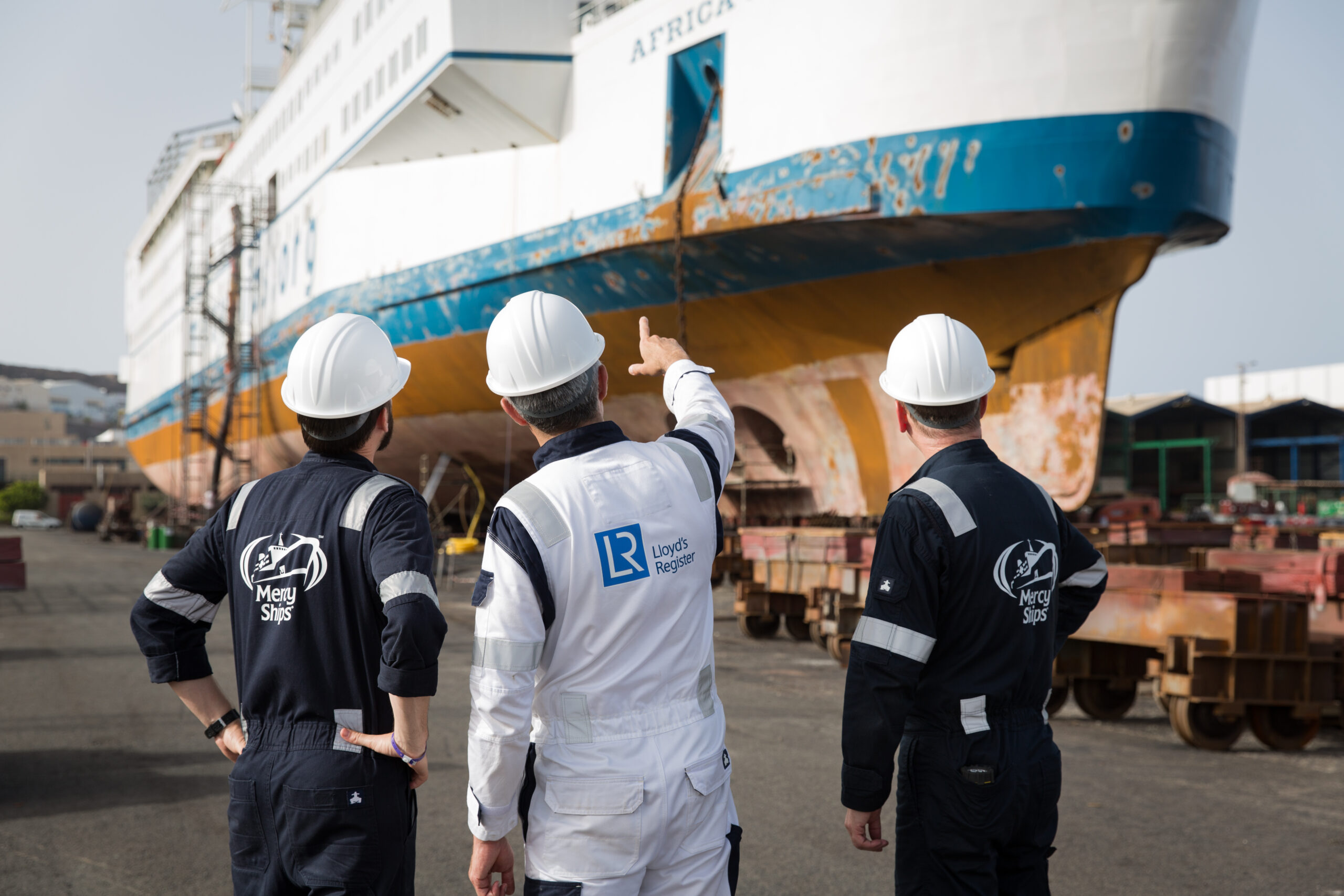
The investment on Global Mercy serves as a genuine model for governments and businesses in fulfilling the United Nations’ Sustainable Development Goals.
‘We feel excited for playing a part in the journey of these civilian hospital ships that bring hope and healing at destinations where people do not have access to resources. It is encouraging to see individuals from
around the world contributing to Mercy Ships in various ways from sharing knowledge to supplying equipment, fund raising and sponsoring volunteers. By individuals, I mean my colleagues as well as many of our clients. Once on board you would be inspired by professional volunteers who often choose to serve in capacities inferior to their actual educational and competence level, and such behaviour is a rare commodity,’ Moin comments.
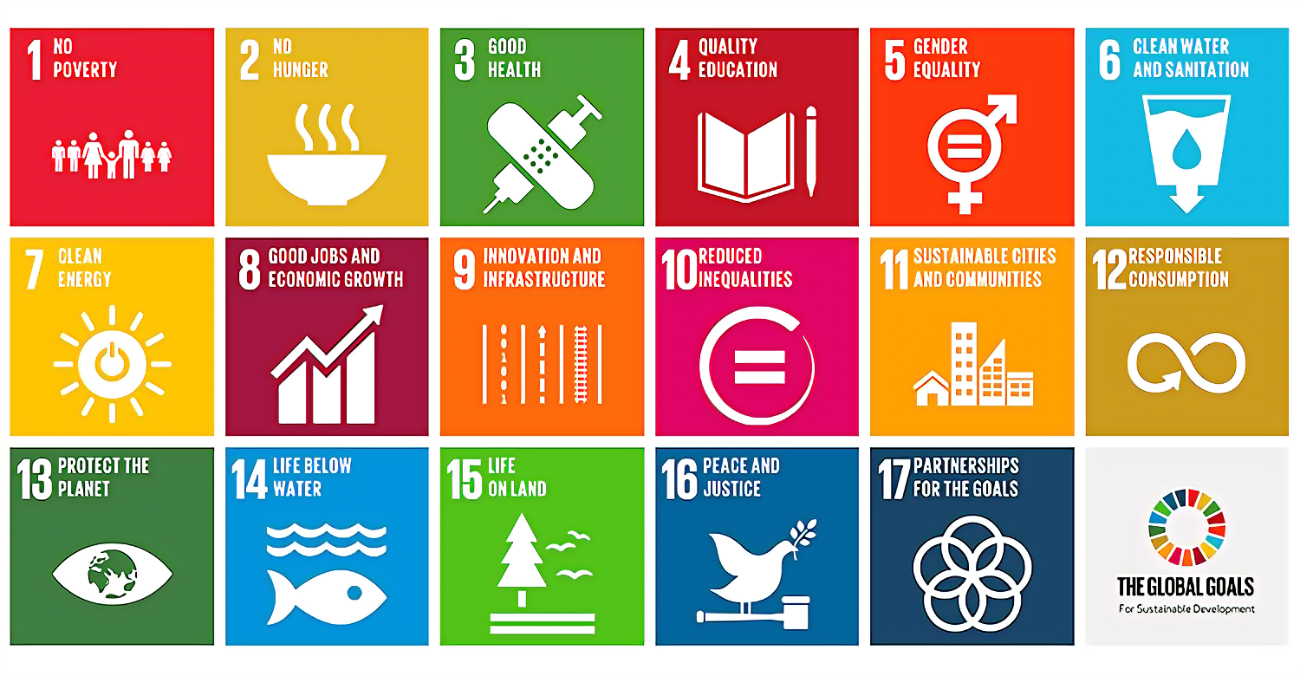
Renewable power
With rising fuel prices and concerns over CO2 emissions, what options are there? Global Mercy and Africa Mercy spend most of their time alongside in West African ports blessed with plenty of sunshine. As power demand on board peaks during daytime, perhaps it can be supplied, at least partly, by solar panels. As such marine alternative energy sources are being developed and tested even afloat on the Dutch North Sea, is there a possibility to introduce them on board these hospital ships or alongside ashore?
Interesting thoughts deserving consideration and study by young scientists and entrepreneurs. Clearly, Mercy Ships will welcome focused contributions in engineering, materials, outfitting and service technicians in such novel areas.
Fleet renewal and expansion
During the International Maritime Day on 7 March, a high-level panel of maritime industry leaders went on stage in the ship’s auditorium. Their views on the new ship and its future were moderated by Philippe Holthof, a seasoned veteran in the ferry and passenger shipping world. In a roundtable panel discussion, Holthof asked the congregated CEOs and company directors about their hopes and ambitions for the future fleet renewal and expansion.
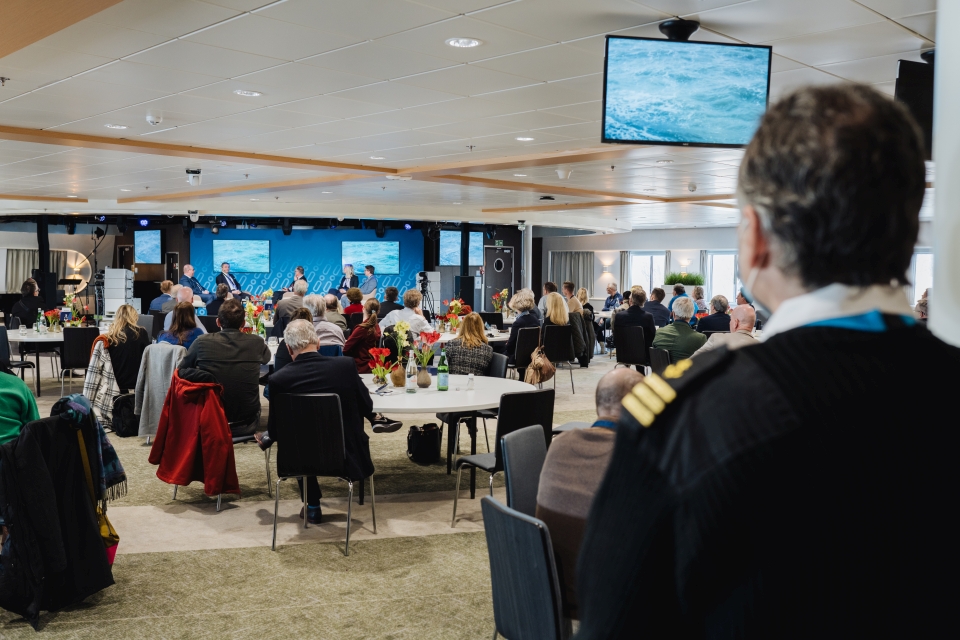
‘I would like to see this magnificent ship as the first of many,’ comments LR CEO Nick Brown. Ever since Brown was regional Director for LR in China, he has actively supported Mercy Ships.
‘Are there already plans afoot to replace Africa Mercy?’ asks Holthof, ‘and if so, by newbuilding or by conversion of a ship of opportunity?’
This is where Mercy Ships’ recent experience with supervising design and construction of a purpose-built hospital ship with optimised layout and a long lifespan comes in. ‘We have already updated the building specifications,’ comments Jim Paterson from the technical team sitting in the audience.
‘And will it be China again?’ is Holthof’s final question. ‘We can bring in our in-depth experience with Chinese shipyards, supply chain, building supervision and local inspection as we always do for our clients. You can be assured to get your desired building quality there. And we will be there to assist Mercy Ships like we did all the way with Global Mercy,’ concludes Stena’s Per Westling.
Picture (top): Global Mercy leaving Rotterdam for Africa (courtesy Mercy Ships).


